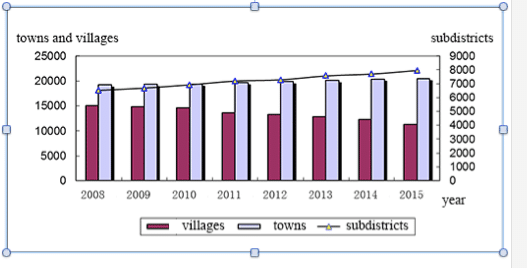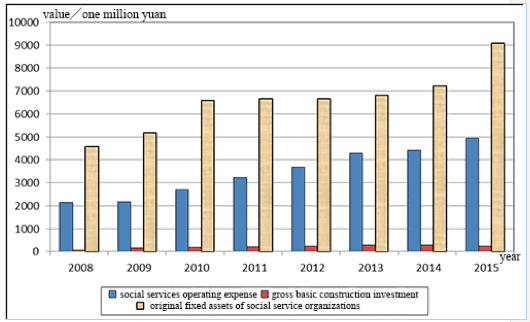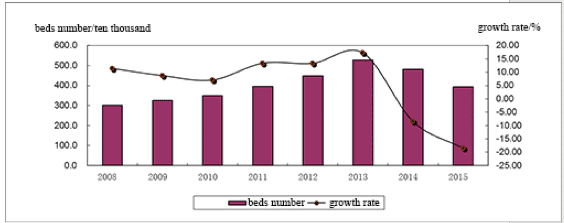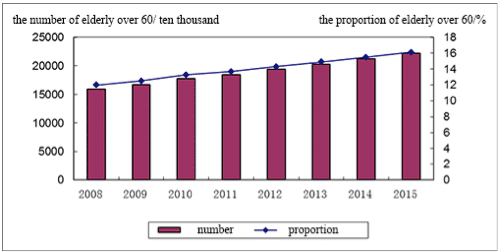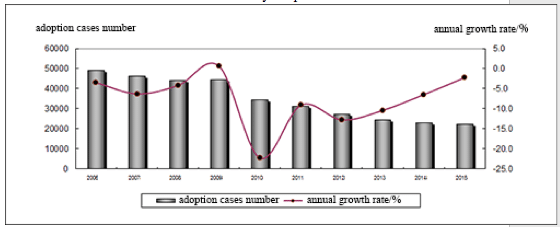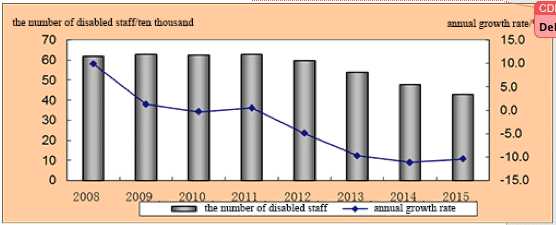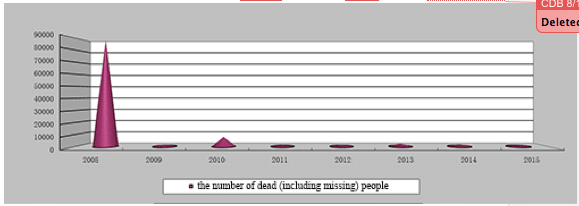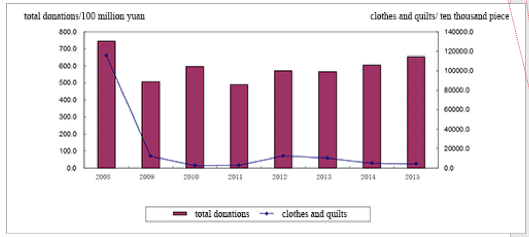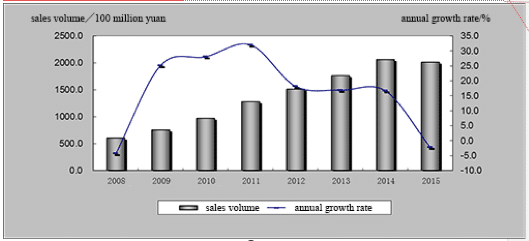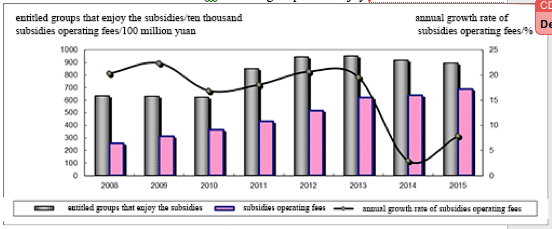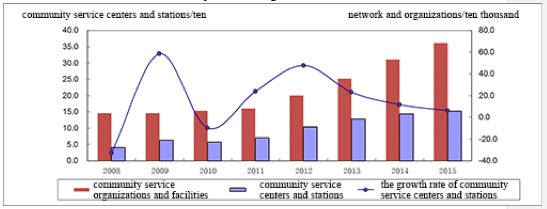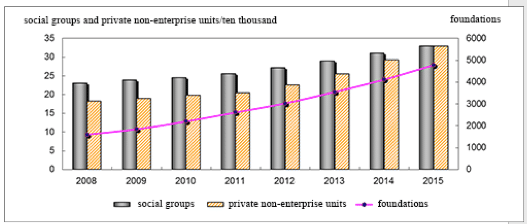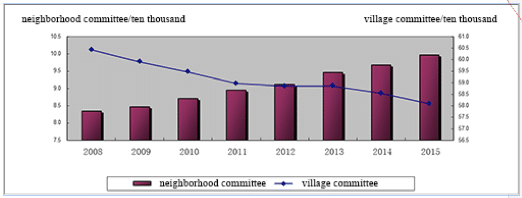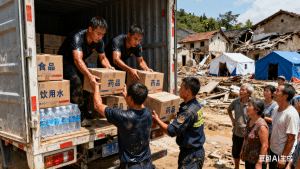During 2015, China’s civil administration has promoted the development of civil affairs by conscientiously implementing the arrangements of the Central Committee of the CPC and the State Council.
-
Overall Statistics
By the end of 2015, China had 34 provincial-level administrative divisions (including 4 municipalities, 23 provinces, 5 autonomous regions and 2 special administrative regions), 334 prefectural-level administrative divisions (including 291 prefecture-level cities, 10 prefectures, 30 autonomous prefectures, and 3 leagues), 2,850 county-level administrative divisions (including 921 districts, 361 county-level cities, 1,397 counties, 117 autonomous counties, 49 banners, 3 autonomous banners, 1 special district and 1 forest district), and 39,789 township-level administrative divisions (including 2 district public offices, 20,515 towns, 10,172 townships, 152 sumu, 990 ethnic townships, 1 ethnic sumu and 7,957 subdistricts). Fourteen provincial boundaries, with a total length of 14,468 kilometers, were jointly inspected by the Chinese government in 2015.
Chart 1. Changes in the number of towns, villages and sub-districts
Table 1. Changes in the number of towns, villages and sub-districts
By the end of 2015, according to the annual joint provincial inspection, there were 1,765,000 social service institutions with a year-on-year increase of 5.8%; 13,089,000 members of staff, with a year-on-year increase of 4.6%; total fixed assets of 818,310,000 Yuan, with a year-on-year increase of 13.4%; a construction scale of 40,873,000 square meters for projects in the social service industries, with a total annual investment of 23,990,000,000 Yuan, and an expenditure of 492,640,000,000 Yuan on social service work, with a year-on-year increase of 11.9%, accounting for 3.3% of China’s total fiscal expenditure.
Chart 2. basic value of social services
Table 2. basic value of social services
-
Social Work
- Social Services with Accommodation Provided
By the end of 2015, there were 31,000 social service organizations providing accommodation registered all over China. Eighteen thousand of these registered as institutions, with an annual increase of 12.5%, and twelve thousand registered as civil non-enterprise units. In total these social organizations took in 2,316,000 people, providing 3,932,000 beds.
Chart 3. beds provided by social service organizations
Table 3. beds provided by social service organizations
Note: since 2014, the statistical requirements for social service organizations have been adjusted to include those registered with the Administration for Industry and Commerce, the Office of Government Set-up Committee, and the Department of Civil Affairs. Social service organizations without registration, which were included according to the original requirements, have been shifted to the category of social service facilities.
2.1.1 Social Services for Housing the Elderly
There were 116,000 organizations and facilities providing services for housing the elderly nationally in 2015, with an annual increase of 23.4%. Out of this number, there were 28,000 registered elderly care organizations, 26,000 community elderly care organizations and facilities, and 62,000 elderly care facilities based on mutual assistance. The number of beds for all kinds of elderly care amounted to 6,727,000, with an annual increase of 16.4% (30.3 beds for every thousand old people on average, with an annual increase of 11.4%), including 2,981,000 beds for community accommodation and daycare.
2.1.2 Social Services for Mental Health Patients
There were 242 service organizations for people with mental disabilities and illnesses administrated by the Ministry of Civil Affairs, with 78,000 beds provided. 151 social welfare homes (mental hospitals) provided 49,000 beds (equal to last year’s level) and adopted 40,000 people from all sectors, and 91 mental hospitals for ex-soldiers provided 30,000 beds and adopted 24,000 people in 2015.
2.1.3 Social Services for Child Welfare and Protection
753 service organizations for child welfare and protection provided 100,000 beds and took in 56,000 people, including 478 child welfare organizations which provided 89,000 beds and 275 juvenile protection centers which provided 11,000 beds and assisted 47,000 juvenile vagrants and beggars.
2.1.4 Other Social Services
Nationally there were 2439 other kinds of social service organizations that provide accommodation, providing 171,000 beds. Out of these 1766 assisting and managing organizations provided 103,000 beds and adopted 3,705,000 vagrants and beggars of all kinds. 3,187,000 people were given assistance in the designated stations and 518,000 were given assistance outside of the stations. There were also 15 farms and 320 army supply stations arranged for.
Social Services not Providing Accommodation
-
- Services for the Elderly
By the end of 2015 there were 222,000,000 people over 60 years old, accounting for 16.1% of the total population, including 143,860,000 people over 65 years old, accounting for 10.5% of the whole population. There were 2,280 institutions, 21,000 legal aid centers, 71,000 right maintenance and coordination organizations, 53,000 schools for the elderly with 7,328,000 students, and 371,000 activity rooms of all kinds for the elderly. 21,551,000 elderly people enjoyed senior allowances, 265,000 enjoyed nursing allowances, and 2,579,000 enjoyed aging service allowances.
Chart 4. the proportion of elderly over 60 out of the whole population
Table 4. the proportion of elderly over 60 out of the whole population
2.2.2 Child Welfare and Adoption Registration
By the end of 2015 there were 502,000 orphans in China, 92,000 of whom were taken care of by welfare agencies, while 410,000 remained unsettled. There were 22,000 cases of family adoption registration nationwide, including 19,000 by mainland residents, 179 by Hong Kong, Macau, Taiwan and overseas Chinese, and 2942 by foreigners.
Chart 5. family adoption
Table 5. family adoption
2.2.3 Service Organizations for the Disabled
By the end of 2015, China had 15,000 organizations for the disabled, providing job positions for 429,000 disabled people and creating fixed assets of 177,880,000,000 Yuan and profits of 8,140,000,000 Yuan.
Chart 6. the number of disabled staff in disabled-oriented service organizations
Table 6. the number of disabled staff in disabled-oriented service organizations
2.2.4 Social Aid
2.2.4.1 Subsistence Allowances in Urban Areas
By the end of 2015, the subsistence allowances in urban areas, which took up 71,930,000,000 Yuan of the financial expenditure at all levels in 2015, covered 9,574,000 families and 17,011,000 persons. The average standard of monthly subsistence allowances in urban areas was 451.1 Yuan per person, with a year-on-year increase of 9.5%, and the average monthly subsistence allowance was 316.6 Yuan per person, with a year-on-year increase of 10.9%.
2.2.4.2 Subsistence Allowances in Rural Areas
By the end of 2015 the subsistence allowances in rural areas, which took up 93,150,000,000 Yuan of financial expenditure at all levels in 2015, covered 28,462,000 families and 49,036,000 people. The average standard of yearly subsistence allowance in rural areas was 3,177 Yuan per person, with a year-on-year increase of 14.4%, and the average yearly subsistence allowance was 1,766 Yuan per person, with a year-on-year increase of 13.8%.
2.2.4.3 Assistance and Housing for Poverty-stricken People in Rural Areas
By the end of 2015, assistance and housing covered 5,167,000 poverty-stricken people in rural areas, with an annual drop of 2.3%. Financial departments at all levels spent 21,000,000,000 Yuan on assistance and housing for this category of people in 2015, with an annual increase of 10.6%. Among all those receiving the services, 1,623,000 people were collectively supported under a standard of 6025.7 Yuan per person per year, with an annual increase of 12.2%, and 3,544,000 people were separately supported under a standard of 4490.1 Yuan per person per year, with an annual increase of 12.1%.
2.2.4.4 Traditional Assistance
638,000 people received traditional assistance in 2015.
Chart 7. basic assistance to the poor
Table 7. basic assistance to the poor
2.2.4.5 Medical Assistance
In 2015, a total of 6,170,000,000 Yuan was spent to support the basic medical insurance of 66,347,000 people, with an average support of 93 Yuan per person. Direct medical assistance covered 28,891,000 people, with an expenditure of 23,680,000,000 Yuan, including 20,870,000,000 Yuan on the inpatient assistance for 13,079,000 people and 2,800,000,000 Yuan on the outpatient assistance for 15,812,000 people.
2.2.4.6 Temporary Assistance
In 2015, temporary assistance covered 6,554,000 families, including 6,335,000 locally registered families and 219,000 non-locally registered families.
2.2.5 Disaster Prevention and Reduction
Natural disasters of all kinds affected 190,000,000 people to different degrees in 2015. Out of these, 967 died or went missing and 6,444,000 had to be urgently sheltered in other places; natural disasters struck 21,769,800 hectares of crops, out of which 2,232,700 hectares were demolished; disasters also caused 248,000 houses to collapse and damaged 2,505,000 other ones. Economic losses due to natural disasters reached 270,410,000,000 Yuan in 2015. The China National Commission for Disaster Reduction and the Ministry of Civil Affairs initiated the national disaster emergency response for 20 times, aiding a total number of 60,000,000 victims. They also allocated a subsistence allowance totaling 9,472,000,000 Yuan to disaster-stricken provinces and provided people with life relief materials, including 47,000 tents, 161,000 quilts, 110,000 cotton-padded overcoats, 23,000 sleeping bags and 50,000 folding beds. This support played a crucial role in major natural disasters including the powerful Nepalese earthquake that affected the Shigatse region in Tibet, the Cangyuan earthquake in Yunnan, the Pishan earthquake in Xinjiang, Typhoons Soudelor and Mujigae, and rainstorms, floods and hail in the southern areas. 1390 model communities to reduce disasters have been established all over China in 2015.
Chart 8. the number of dead people (including those missing)
Chart 8. the number of dead people (including those missing)
2.2.6 Philanthropy
2.2.6.1 Donations
By the end of 2015, the number of regular public donation workstations, stops and philanthropy supermarkets amounted to 30,000 (the number of philanthropy supermarkets was 9654). Donations of 65,450,000,000 Yuan were received in total throughout the year, including 4,420,000,000 Yuan directly received by the civil affairs departments and 61,030,000,000 Yuan received by social organizations of all kinds. The civil affairs departments directly received 45,370,000 items of clothing and quilts, for a value of 520,000,000 Yuan, and it also received 430,000,000 donations and 1,725,000 items of clothing and quilts from other departments, for a value of 61,644,000 Yuan. 18,284,000 people benefited from the donations and 9,346,000 people did voluntary jobs amounting to a total of 27,007,000 hours in the social services field.
Chart 9. donations and clothes and quilts received
Table 9. donations and clothes and quilts received
2.2.6.2 Welfare Lotteries
Welfare lottery tickets for a value of 201,510,000,000 Yuan were sold in China in 2015, 4,460,000,000 Yuan less than in 2014, with a decrease of 2.2%. The funds raised through welfare lotteries amounted to 56,380,000,000 Yuan, with an annual decrease of 3.7%. The total expenditure of the funds from the welfare lotteries was 28,890,000,000 Yuan, 5,760,000,000 more than in 2014, with an increase of 24.9%, including 690,000,000 Yuan spent on pensions, 20,000,000 on settlements after retirement, 18,210,000,000 on social welfare, 3,000,000,000 on social aid, 190,000,000 on aid after natural disasters and 4,360,000,000 on other fields.
Chart 10. welfare lottery
Table 10. welfare lottery
2.2.7 Subsidies for Entitled Groups
By the end of 2015, China’s subsidies for entitled groups covered 8,970,000 people, including 737,000 injured or disabled servicemen, 1,184,000 ill veterans returned homed, 792,000 demobilized servicemen, 3,925,000 veterans with a rural registered residence over 60 years old, 177 Red Army veterans who returned home, 64 West-Road Red Army veterans who returned home, 3708 lost Red Army soldiers, 161,000 close relatives of martyrs, and 104,000 close relatives of soldiers who died in the line of duty or from illnesses.
Chart 11. the number of entitled groups that enjoy subsidies
Table 11. the number of entitled groups that enjoy subsidies
A further 341 people were entitled to be treated as relatives of martyrs in 2015. There were 1464 registered institutions established to manage the memorial facilities for martyrs, covering a land area of 4,442 hectares by the end of 2015. 35,000 memorial facilities for martyrs were established within institutions and 12,000 ones were established outside of them.
2.2.8 Community Service
By the end of 2015, China had 361,000 community service organizations and facilities of all kinds, covering 52.9% of all service institutions. Out of these, there were 863 community service guide centers, 24,000 community service centers (with an annual increase of 4.3%), 128,000 community service stations (with an annual increase of 6.7%), 26,000 community aging service institutions and facilities (with an annual increase of 36.8%), 62,000 aging service facilities with mutual assistance (with an annual increase of 55%), and 120,000 other community service facilities (with an annual increase of 12.1%). There were also 249,000 service networks bringing convenience and benefit to urban residents and 96,000 community voluntary organizations.
Chart 12. community service organizations and facilities
Table 12. community service organizations and facilities
Membership Organizations and Other Social Services
3.1 Membership Organizations
3.1.1 Social Organizations
By the end of 2015, there were 662,000 social organizations nationwide, with an annual increase of 9.2%; these organizations provided jobs for 7.35 million people, with an annual increase of 7.7%. The total annual income of these organizations was 292.9 billion Yuan and the total expenditure 238.38 billion Yuan; 231.11 billion Yuan was turned into fixed assets. These organizations received 61.03 billion Yuan of donations from different social groups and the general public. The total number of investigated illegal cases within social organizations in 2015 was 2951, leading to 23 ones being banned and 2928 ones receiving an administrative penalty.
In 2015 there were 329,000 social groups nationwide, with an annual increase of 6.1%, including 37,000 business service groups, 17,000 technological research groups, 10,000 educational groups, 10,000 health groups, 48,000 social service groups, 33,000 cultural groups, 23,000 sport groups, 7,000 environmental groups, 3,000 legal groups, 5,000 religious groups, 62,000 rural/rural development groups, 21,000 career groups, and another 53,000 non-categorized groups. Out of all these social groups, the total number of investigated illegal cases in 2015 was 1681, which led to two groups being banned and 1679 ones receiving an administrative penalty.
There were 4784 foundations nationwide, with an annual increase of 667 foundations (16.2%), including 1548 public fundraising foundations and 3198 non-public fundraising foundations. There were 202 foundations registered with the Ministry of Civil Affairs, 9 international foundations, and 29 representative institutions of foreign foundations. Public and non-public fundraising foundations received 43.93 billion Yuan donations from the general public. The number of administrative penalties was 16.
There were 329,000 civil non-enterprise units, with an annual increase of 12.7%, including 16,000 organizations involved in technological services, 433 environmental ones, 183,000 educational ones, 24,000 health ones, 49,000 social service ones, 17,000 cultural ones, 14,000 sport ones, 3,355 business service ones, 114 religious ones, 7 international ones and another 19,000 non-categorical ones. Among all the civil non-enterprise units, the total number of investigated illegal cases in 2015 was 1254, leading to 21 units being banned and 1233 ones receiving an administrative penalty.
Chart 13. Number of social organizations
Table 13. Number of social organizations
3.1.2 Autonomous Organizations
By the end of 2015, there were 681,000 autonomous organizations at the grassroots level, including 581,000 village committees and 4692,000 villagers’ groups, 100,000 neighborhood committees and 1347,000 residents’ groups. The village committees had 512,000 members and the neighborhood committees had 2297,000 members with an annual increase of 3%. 165,000 village (neighborhood) committees held elections in 2015, with 210,000,000 villagers (residents) registered to participate in the vote and 160,000,000 ones actually voting.
Chart 14. Number of autonomous organizations
Table 14. Number of autonomous organizations
Notes
- The “villages” in the Chart 1 and Table 1 include townships, sumu[1], ethnic townships, and ethnic sumu.
- The central funds allocated by the Ministry of Finance and the Ministry of Civil Affairs don’t include the purchase fees for relief materials and some funds appropriated by the Xinjiang Production and Construction Corp.
- The reference for social organization’s donations is the 2015 survey’s statistics (reporting on the situation in 2014).
- The number of people mentioned in the article reflects the actual situation, and the number of institutions covers those registered in a legally-binding fashion. The numbers are not equal to the approved, planned and predicted ones.
- Some data in this article is rounded off so that the breakdown data may not amount to the aggregated data.
- Hong Kong, Macau and Taiwan are not included in this article.
[1] The “sumu” (苏木) is an administrative subdivision of Inner Mongolia

